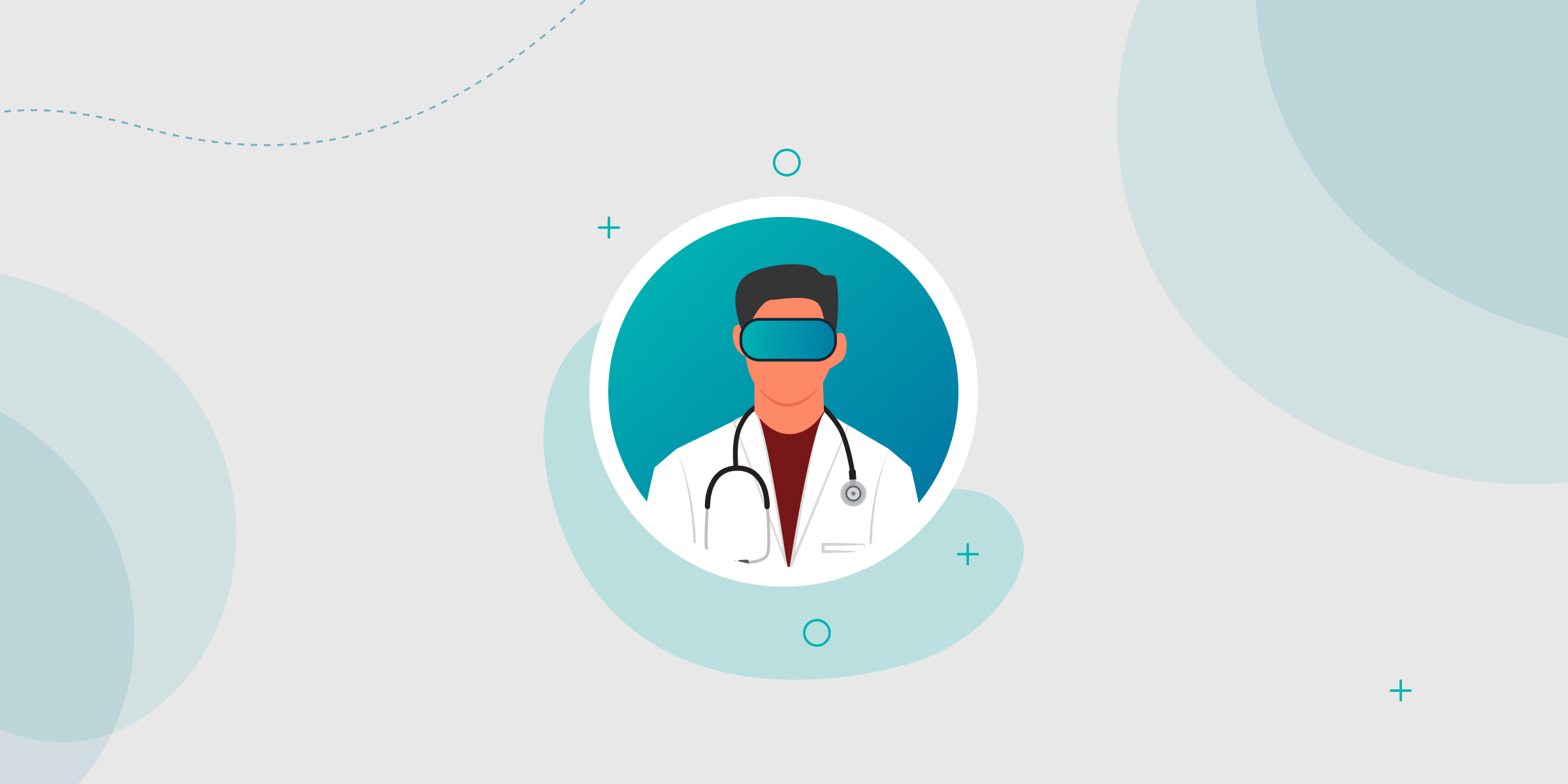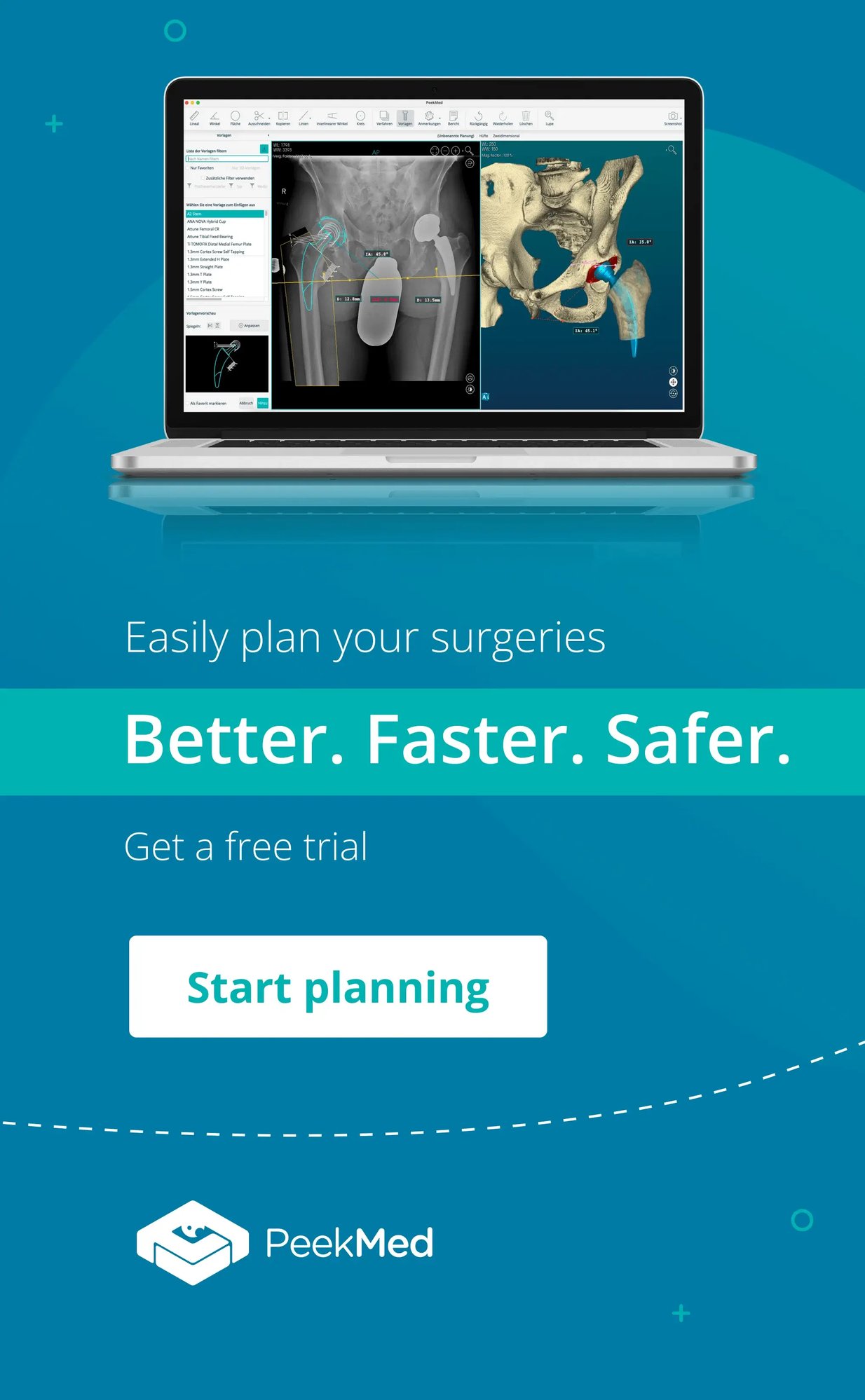PeekMed
The orthopedic technology trends market is rapidly expanding, with new applications emerging frequently. Deep Learning and Generative AI are significant components of this evolution, and this article highlights them. Additionally, there are many other solutions available that can enhance your medical practice.
What is Orthopedic Technology?
Orthopedic technology is a broad concept where technology is used to support orthopedic healthcare professionals in clinical practice. While this is not (yet) a coined term, it includes a lot of concepts.
Types of orthopedic technologies might include:
Deep Learning and Generative AI
Digital Templating
Augmented Reality
PACS — Picture Archiving and Communication System
CAS — Computer-Assisted Surgery
Big Data
If you would like to know more about orthopedic technology trends, please, follow along.
Deep Learning and Generative AI: Surgical Planning made smart
In the rapidly advancing field of orthopedics, the convergence of Deep Learning (DL) and Generative Artificial Intelligence (AI) is reshaping preoperative planning with its speed and accuracy. This integration brings forth a shift in the way surgeons prepare for and execute orthopedic surgeries, leveraging the capabilities of AI to enhance precision and tailor interventions to individual patients.
DL plays a pivotal role in preoperative planning by revolutionizing the analysis of medical imaging. Trained on extensive datasets of orthopedic images, DL algorithms excel in recognizing subtle anomalies, fractures, and intricate structural variations. This empowers surgeons with a deeper understanding of a patient's musculoskeletal condition, enabling more accurate preoperative assessments.
Generative AI takes personalization in preoperative planning to a new level. By analyzing a patient's unique anatomical features, movement patterns, and medical history, Generative AI algorithms can generate simulations predicting the outcomes of different surgical approaches. Surgeons can then explore various scenarios and craft a surgical plan that aligns with the individual characteristics of the patient.
One notable application of Generative AI in orthopedics is the customization of implants and prosthetics for procedures like arthroplasties. By analyzing patient-specific data, including bone structure, joint movement patterns, and other relevant factors, Generative AI algorithms can design implants tailored to individual anatomies ensuring optimal placement. This not only enhances the precision of surgeries but also contributes to improved patient outcomes and reduced recovery times.
The real-time decision support capabilities of DL and Generative AI are particularly noteworthy. These technologies can continuously analyze intraoperative data, offering dynamic insights to surgeons. This real-time assistance proves invaluable in adapting to unforeseen challenges during surgery, ensuring that the surgical plan remains flexible and responsive to the unique complexities of each case.
Digital Templating: Always updated
Templating is the process of choosing the most adequate size of an implant. Traditional templating methods require physical overlays on X-rays, but digital templating brings this process into the digital realm.
Surgeons can now use advanced imaging techniques to create precise digital templates, allowing for a more comprehensive understanding of the patient's anatomy and optimal implant sizing.
With this integrated knowledge, orthopedic surgeons can anticipate what implants they need. This leads to better stock management and reduces sterilization needs.
Also, surgeons can visualize and manipulate digital templates in real time during surgery, ensuring that the chosen implants align perfectly with the patient's anatomy. This level of precision contributes to better outcomes, shorter recovery times, and increased patient satisfaction.
Other than automating processes, orthopedic digital templating allows surgeons always to be up-to-date. New templates and biomedical materials are constantly updated in digital databases, which can be accessed and updated.
In navigating the evolving landscape of orthopedic technology, understanding the trajectory of the orthopedic implant industry can provide valuable insights.
Augmented reality: What orthopedics can learn from Pokemon GO?
Pokemon GO introduced augmented reality (AR) to the common citizen, importing the cinematic idea we had regarding virtual reality. But AR has transcended its gaming origins to become a valuable tool in orthopedic surgery.
Augmented reality is a display technology that combines the real world with the virtual world. It allows digital images or preoperative planning information to be combined with the surgeon’s view of the real world.
AR can increase the surgeon’s view of unexposed bones and other tissues during surgery while using less invasive techniques. Structures once only seen invasively or through 2D pictures — such as ligaments or bones — become 3D images projected onto patients.
Surgeons can also visualize critical data, such as pre-operative plans and imaging, directly within their line of sight, leading to more informed decision-making and improved accuracy.
AR is not limited to the operating room; it's also transforming the way orthopedic surgeons are trained. Medical professionals can now engage in realistic simulations using AR, allowing them to practice and refine their skills in a risk-free virtual environment. This technology contributes to the continuous improvement of surgical techniques and the ongoing education of orthopedic professionals.
These different applications can be found in PeekMed Vision, a project funded by the PRR and the Portuguese Republic. Developed in collaboration with the CCG and 2CA-Braga, it represents an innovative advancement in AR for orthopedics.
PACS: Access files anywhere
PACS, or Picture Archiving and Communication System, is already a reality in many hospitals, but many don’t know about it!
It can quickly be resumed as a cloud-based solution, like Google Drive or iCloud. PACS connects imaging technologies and those who need to access the images collected. This makes it instant and eliminates the need for physical files.
With PACS, orthopedic doctors can quickly retrieve historical images, compare current and past scans, and make more informed decisions. This efficiency is crucial in time-sensitive situations, such as trauma cases, where rapid and accurate diagnoses are vital. PACS has several benefits for the institution and clinical communication.
This is just the beginning: by integrating PACS with other tools, such as PeekMed, surgeons can access and import clinical data. It makes the workflow much faster.
Computer-Assisted Surgery: Superman Vision in the OR
Computer Assisted Surgery, or CAS, is a broad reference. However, it can be resumed to a moment where technology is used to support a surgical procedure.
This technology integrates computer algorithms with surgical instruments, offering guidance and feedback throughout the operation. From joint replacements to spinal surgeries, CAS enhances surgical precision, reducing the margin of error and improving overall outcomes.
Surgeons receive continuous updates and recommendations based on real-time data, ensuring that each step aligns with the pre-operative plan. As a practical example, orthopedic surgeons might use navigation technologies during spine surgery to achieve precise viewing, tracking, and angling— almost as good as Superman's X-ray vision!
A CAS might start even before entering the operations room, taking full advantage of imaging technologies and preoperative orthopedic technology.
If it sounds confusing, a quick guide might help you understand the full advantages of Computer Assisted Surgery.
Big Data: Decide based on evidence
In the landscape of orthopedic technology, Big Data plays a pivotal role in driving evidence-based decision-making. Often synonymous with Data Science, Big Data empowers orthopedic professionals by providing comprehensive and actionable insights.
Big Data supports various orthopedic technologies discussed earlier, including Deep Learning e Generative AI, and Augmented Reality.
Big Data can analyze vast datasets to uncover valuable insights. Orthopedic professionals can analyze trends, treatment outcomes, and patient demographics, leading to more personalized and effective interventions.
Moreover, the integration of Big Data in orthopedics enables predictive analytics, helping healthcare providers anticipate potential complications, optimize resource allocation, and streamline workflow efficiency. This proactive approach contributes to the overall improvement of patient care and the effectiveness of orthopedic interventions.
You can read more about the benefits of Big Data in Healthcare and in Orthopedics.
Best orthopedic technology: What should I use?
What kind of technology is used in orthopedic surgery depends on what you are looking for. The key idea is that most of these tools can be integrated into each other, making them truly valuable.
However, keeping up-to-date might be a bit overwhelming as a lot can change quickly. We hope this short guide will help you find what suits you better.
On our end, we will keep you updated on new orthopedic (surgery) technology. To predict the future we often debate with experts about the future of orthopedics.









